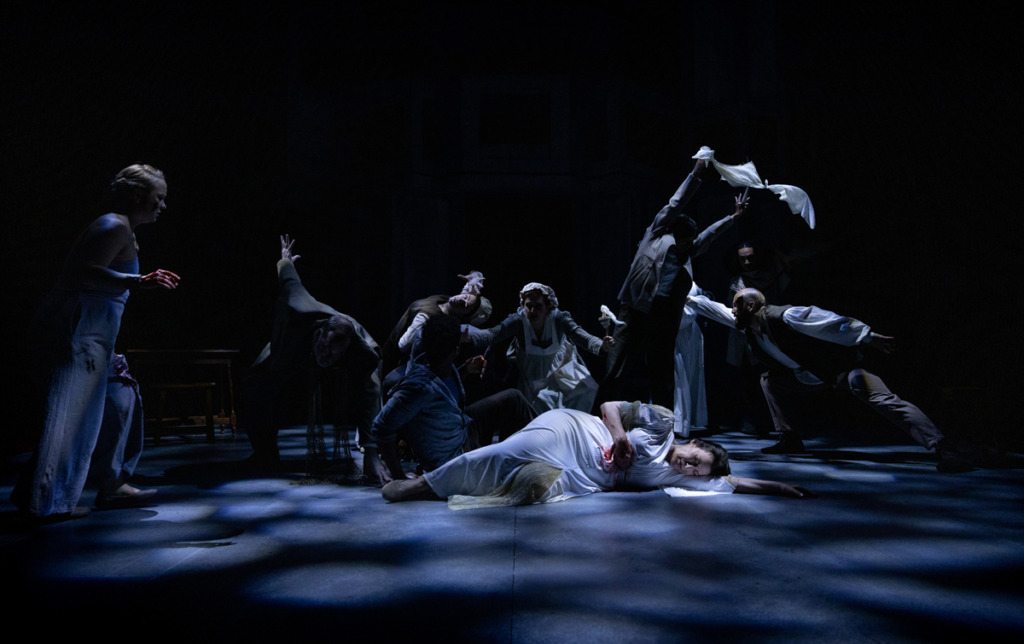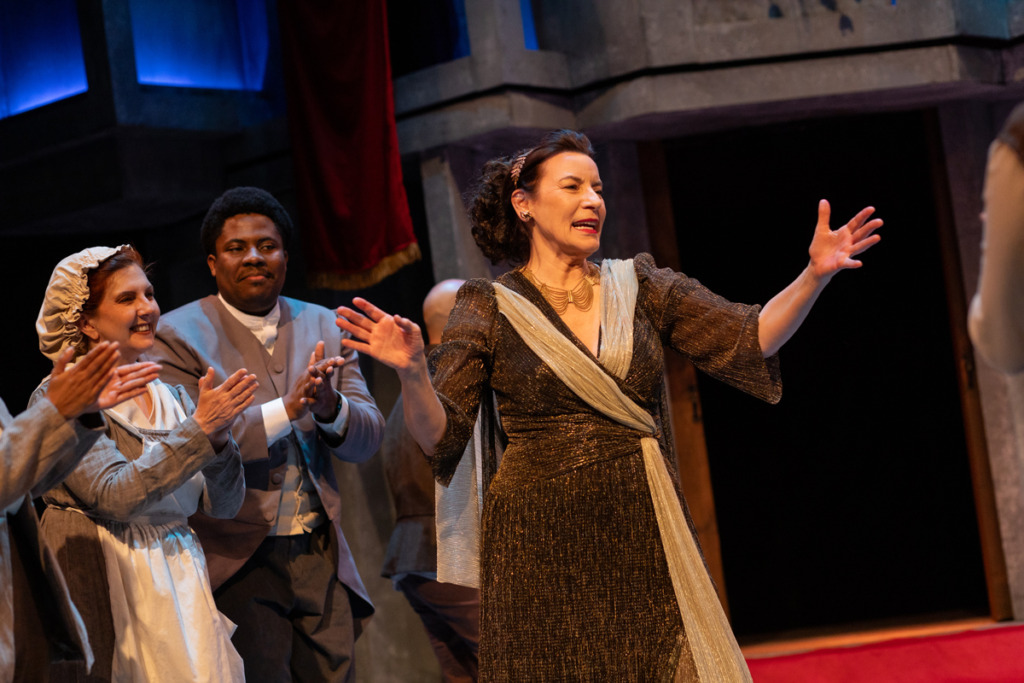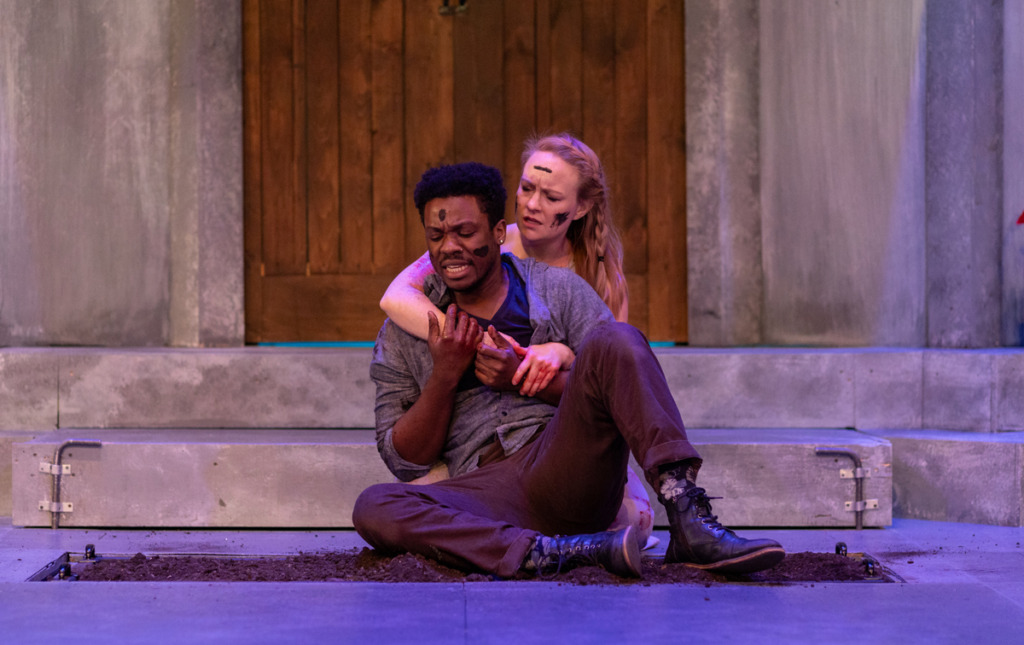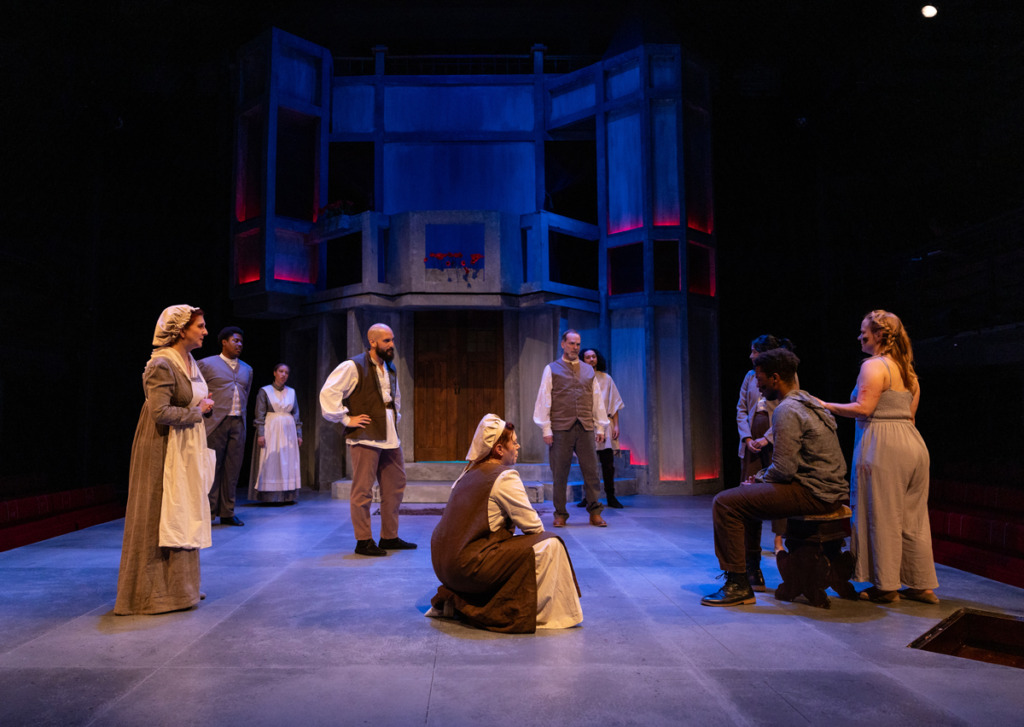Do I remember this? Or is this what’s about to happen? This is no dream. This is no vision. This is the truth. Profound words. Or are they questions? What are words if not questions? You’ll hear them over and over— though never truly in one voice as one might expect from a chorus in a Greek tragedy; their effect, however, is no less striking. Chesapeake Shakespeare Company presents The Oresteia freely adapted from Aeschylus by Ellen McLaughlin and directed by Lise Bruneau. A remarkably modern yet seemingly timeless adaptation, The Oresteia marks CSC’s 96th main-stage production, only their second Greek play, and their first ever Greek Tragedy.

Ellen McLaughlin’s adaptation blurs the lines between source material and her own liberal licensing though that’s hardly a bad thing in this case. If a little overly simplistic in the back half of the script, the story’s essence is told in a captivating, not-quite-modern yet not-quite-ancient fashion. What’s most impressive about her adaptation is the presentation of the Greek Chorus. The unified chanting that is expected with an entity like a Greek Chorus is there only it’s been deconstructed; you get each of the chorus members repeating a word or phrase, just a breath or beat behind another chorus member. So you get the sense that they are of one voice while still being individuals. They are group— a community— rather than one all-speaking-plot-device. For McLaughlin’s adaptation, which seems to focus somewhat more heavily on the ‘The Libation Bearers’ portion of The Oresteia, they are the servants. But they are more than mere commentators and observers (though they are also that) they become the reflective portal of humanity, particularly the second act winds into its conclusion. It’s wondrous strange, the way they act and interact with one another, with the other characters, and more subtly with the audience, whereas more traditionally staged Greek dramas have them serving almost exclusively as the narrative explanation for what’s happening.
There’s a profundity to McLaughlin’s approach to the Chorus, particularly as they conduct this decisive trial-and-jury show when it comes to the judgement of Orestes, once again calling back to their role as the mirror to humanity. This section of the play could lead to dissertation-level debates about what is justice, who is justice really for, and where does that thin line land between innocent inaction and guilt for lack of action. Should the whole world wander around blind and toothless when you take up the vicious cycle of an eye for an eye? Does blood only begat more blood and can a cursed house born of blood ever truly be cleansed? Remarkable conversational topics called into question by eight differing opinions all bickering over who is ‘right’ or what is ‘right’ when it comes to these decisions.
Director Lise Bruneau delves into that notion and the closing imagery of the performance is one of the most striking moments in the show (at least it was for me.) As presented, the chorus are the servants— the help. And what does the help do? They clean up. So that image of the final action on stage— even after all of the discourse and debate— is so stark and really punctuates that notion of “at the end of the day…chorus or not…they’re just the help.” And it’s profound and disturbing and completely brilliant. Bruneau should also be commended for her exceptional pacing; the show moves at a clip, coming in at nearly exactly two hours with the intermission. And yet it never feels rushed.
Working in tandem with her design team— Katie McCreary on lights, Sarah O’Halloran on sound and the show’s original score composition, Kathryn Kawecki on set, and Kristina Lambdin on costumes— Bruneau creates this epic piece of theatre that feels so small and yet packs such a powerful punch all at once. The towered turrets with frosted glass centers are a remarkable use of the stage’s fixed scenery; Kawecki’s design work here lends itself to the visual terrors of what’s to come in this tragedy. That moment, like so many others, are underscored sublimely by O’Halloran’s sound design and musical creations, and effectively augmented by striking splashes of McCreary’s colorful lighting. There are even moments— almost like still-captures from a motion picture— that flash like something out of a horror film. It’s a visual resplendence across the board, but only in glimpses as much of the production is dominated by the drab grays and browns of everyday misery that dwells in the house of curses and sorrows (and by proxy all its inhabitants.) Lambdin’s costuming follows in a similar vein, though the robust red robe in which Clytemnestra initially appears is brash foreshadowing for the bloodbath that is to come.

On the whole, the major issue with the production seemed to be acoustics. There were multiple moments where quieter exchanges were occurring and either voices were forgetfully hushed or nobody has reminded/informed these actors of the unique challenges presented the staging-space at CSC. This was most often an issue for the Clytemnestra character, though happened for others throughout the performance.
As Clytemnestra, Isabelle Anderson gave an uneven performance on opening night. Maybe I poisoned my own mind against her by reading Executive Director Lesley Malin’s note about catharsis, which did prime my mind (someone who knows, has read, and has seen multiple adaptations of The Oresteia) for that expected payoff when Agamemnon returns home. The visuals are there— blood soaked costume, bloody body bags— and Anderson looks every bit the part. But her delivery in that moment was anything but cathartic. It felt a bit like a table read rather than the bombastic expression of catharsis that comes indicated with the lines she’s delivering. To her credit, however, Anderson’s severity in the scenes leading up to that were on point. Her oddly dismissive humors (which resurge tenfold in the second act after she’s encountered a taste of her own medicine as it were) and snappy sardonic one-liners are exceptionally well delivered. When she re-appears after ‘the incident’ in the second act, she’s riveting. But then early on, when attempting to comfort Iphigenia (the delightfully talented Charlotte Molitoris, whose character’s presence creeps and recurs all throughout the performance in a fashion most unsettling) and interact with Agamemnon (Stephen Patrick Martin; the character of Agamemnon features far less significantly in this adaptation than in Aeschylus’ original), she feels unintentionally detached. Like she’s acting the part of someone who is supposed to be aloof, rather than simply being aloof. It’s difficult to say whether this was a directorial choice or if Anderson was just having an off night. A mixed bag on the whole for the person who could arguably be considered the show’s lead as she’s given the final bow at curtain-call.
Cassandra (Emily Erickson) is the character I think many would wish there was more of in this adaptation; I certainly do. Erickson spends the first series of moments of her character’s existence in disturbing silence, with facial expressions and body language and overall movements that almost mimic a frightened bird; it’s fascinating to watch. And then when she finally does speak, she fully embodies the notion of being from a foreign land, adapting an accent to sound almost Trojan, something different and ‘othered’ from the land to which she has been brought. Everything about her performance is jarring and jolting but in an indescribably exciting way, one that makes you want more of whatever it is she’s experiencing.

Lizzi Albert’s performance as Electra is— pardon the pun— somewhat electrifying. She’s a jolt to the overall energy on the stage, largely because she sounds a bit more modern than the other characters. You almost don’t mind it because she’s so vivacious and snappy, particularly as she bites back at Clytemnestra. It’s not off-putting, just noticeable. There’s a serenely subdued moment shared between Albert and Isaiah Mason Harvey, as brother Orestes, when they pray together over the dirt plot in front of the house doors. As the returned prodigal son, Harvey delivers a mercurial performance. Deteriorating before the audiences’ eyes, Harvey’s Orestes is completely unhinged in his “trapped in this madness” scene; it’s brutally fascinating to watch. But there’s a vulnerability to Harvey’s portrayal as well, something that plunges into the depths of the intrinsic need to be understood. When he tells his story— recounts to the chorus (and the audience) how his ten-year-old self recalls the events of ‘that night’ it’s like traveling inside his younger mind with him and experiencing the strange events in live time; a rarity among performers that he can exist so fully in the moment he’s explaining it while simultaneously living the moment as his younger self recalls it.
This production of The Oresteia belongs unequivocally to the Chorus— Gabriel Alejandro, Hana Clarice, Surasree Das, Lloyd Ekpe, Alie Karambash, Lesley Malin, Dawn Thomas Reidy, and David Yezzi. As mentioned previously, they are of one voice without ever speaking as one voice. It’s a unique approach to the purpose they serve and their existence. Initially one could think them mere background players but that illusion quickly dissolves and one realizes this is much their story— if not more so— than it is the cursed house of Atreus and all its former and future inhabitants. David Yezzi opens the performance atop the third tier of the set, pacing all along the watchtower with the Sisyphean task of waiting for the signal and his voice is later more memorably noted for his cries during the ‘trial-by-for-justice’ scene.
Dawn Thomas Reidy is one of the most engaging members of the Chorus, particularly during her encounter at the gate with Harvey’s Orestes. There is this indecisive, illusive moment of “does she know/doesn’t she know” and her facial expressions directly mirror her vocal inflections; both creating for an engaging character. Similar praises can be lauded upon Lesley Malin, who has a brief interaction with Albert’s Electra, and while Albert drives most of that exchange, Malin’s reactions and responses are captivating. During the penultimate moments of the performance, the Electra character attempts to flip the narrative— asking them if they, as the Chorus, are not just as guilty for their inactions; each of the eight members on stage has a response on their faces that is individually different and yet all silently saying the same thing. It’s an astonishing moment to behold.

Gabriel Alejandro eventually rises above the others in this dithering discourse of ‘blame/judgement/vengeance/retribution’ as the voice of clear and level-headed reason. All eight members of the Chorus are remarkably aware of themselves on stage not only as members of the chorus but in their spatial relationships to both the audience and to the other performers; it nearly defies description in the way it tugs at the lines of their character functions. They are a remarkable force as one unit and yet are each individualized multiple times over. One of their most memorable instances of existence— both together and individually— is summed up in two repetitive words, “And yet.” It’s truly remarkable.
There they all are, standing outside the door of history, waiting for you to open it and invite yourself inside with them for this impressive exploration of humanity, as viewed through the adapted lens of a Greek tragedy. Catch The Oresteia while its on stage at Chesapeake Shakespeare Company this season; you won’t regret doing so.
Running Time: 2 hours and 5 minutes with one intermission
The Oresteia plays through March 10th, 2024, with Chesapeake Shakespeare Company— 7 S. Calvert Street in Baltimore, MD. Tickets are available by calling the box office at 410-244-8570 or purchasing them in advance online.
